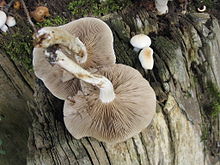Southern arable
| Southern arable | ||||||||||||
|---|---|---|---|---|---|---|---|---|---|---|---|---|

Southern arable ( Cyclocybe cylindracea ) |
||||||||||||
| Systematics | ||||||||||||
|
||||||||||||
| Scientific name | ||||||||||||
| Cyclocybe cylindracea | ||||||||||||
| ( DC. ) Vizzini & Angelini |
The Southern Ackerling ( Cyclocybe cylindracea , syn. Agrocybe aegerita ), also called Southern Schüppling and commonly known in Italy as Piopparello or Pioppino , is a type of mushroom from the family of the Trümmling relatives .
features
Macroscopic features
The approximately 5–10 cm wide hat is brownish and hemispherical when young, then flattened and only darker in the middle, often cracked. The compact lamellae are fine, at first whitish and later brownish in color due to the spore powder . The 5–12 cm long and 1 cm thick stem is whitish in color and has a ring just below the hat. The flesh is firm, white and slightly brownish at the base. It smells inconspicuous.
Microscopic features
The spores are elliptical and brown in color.
ecology
The heat-loving fungus lives on poplar stems, occasionally also on other deciduous trees.
meaning
cultivation
The southern arable is edible. It was already cultivated by the Romans , with ripe lamellas being spread on poplar wood. It is still bred and marketed in Italy and Japan today. The meat of the southern arable has a comparatively firm consistency.
ingredients
The southern arable produces a unique extracellular enzyme that represents a functional hybrid of heme thiolate haloperoxidase and cytochrome P450-dependent monooxygenase ( Agrocybe aegerita peroxidase = AaP). Among other things, it is able to brominate aromatic compounds such as phenol and selectively introduce oxygen functions (OH groups) into poorly activated molecules ( e.g. benzene , naphthalene , pyridine , thioanisole ). The enzyme uses hydrogen peroxide as a cosubstrate and can therefore be called peroxygenase. It is assumed that similar enzymes, which have a promising biotechnological potential, also occur in other leaf mushrooms (Agaricales) (among others in the genus Coprinus ).
swell
literature
- Martin Hofrichter and René Ullrich: Heme-thiolate haloperoxidases: versatile biocatalysts with biotechnological and environmental significance. Appl. Microbiol. Biotechnol. 71: pages 276-288. doi : 10.1007 / s00253-006-0417-3
- René Ullrich and Martin Hofrichter: The haloperoxidase of the agaric fungus Agrocybe aegerita hydroxylates toluene and naphthalene. FEBS Lett . 579/27/2005. Pages 6247-50. PMID 16253244 .
- René Ullrich et al .: Novel Haloperoxidase from the Agaric Basidiomycete Agrocybe aegerita Oxidizes Aryl Alcohols and Aldehydes. Appl. Environ. Microbiol. 70/8/2004. Pages 4575-4581. doi : 10.1128 / AEM.70.8.4575-4581.2004
- Martin Kluge et al. (2007) Spectrophotometric assay for detection of aromatic hydroxylation catalyzed by fungal peroxygenase. Appl. Microbiol. Biotechnol. 75: pages 1473-1478.
- René Ullrich and Martin Hofrichter (2007) Review: Enzymatic hydroxylation of aromatic compounds. Cell. Mol. Life Sci. 64: pages 271-293.
Individual evidence
- ↑ Rita Lüder: Basic course mushroom determination . A practical guide for beginners and advanced users. Quelle & Meyer, Wiebelsheim 2007, ISBN 3-494-01341-1 , p. 272 .


